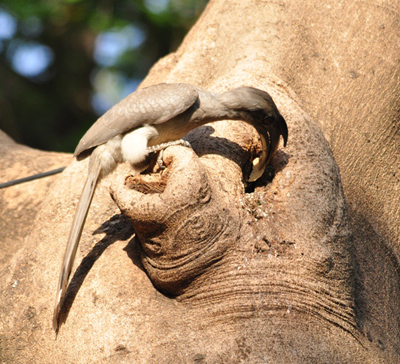An insight view of Indian Grey Hornbill breeding behaviour
Text and Pictures by Ajay Gadikar
Ornithologist, Indore
I had watched a natural hole on a Gulmohar tree which a hornbill pair had used for nesting purposes in last season. This time with the help of the forest department, a CCTV camera, capable of zooming in and out was installed at 5 meters away from the
nest to record its whole breeding cycle almost for a period of 3 months.
A Movie called “UDAN” was made based on the important footages obtained from the 24X7 recording which was later inaugurated by the Chief Minister of Madhya Pradesh.
I will like to share briefly about the general breeding behavior of the IGH.
IGH nesting is very unique. When it is time to lay the eggs, the female hornbill enters the hole of the tree trunk and does not step out into daylight again, until it hatches the eggs and the babies are at least one and half month old, which means she
remains in the nest cavity for 60 to 65 days.
The Female starts to seal the nest cavity once she enters inside. Only a narrow slit of size 3-4 cm by 7-8 cm remains open, from where the Male feeds the Female. The materials used to prepare the wall of the nest cavity are mud, fruit pulp and her own
droppings. The Female now solely depends on the Male for her diet. The Male fetches fig and berries from nearby trees and feeds the female, approximately once in an hour throughout the day. Most of the feeding took place early in the morning. The Male carries
5-8 berries and 1-2 insects in his mouth in one go and regurgitate them one by one into the female beak by clinging himself to the nest.

Once inside the nest, the female lays the eggs and incubates them. Soon the chicks come out of the egg. At the same time the female also undergoes complete moult, by shedding all her feathers. This is a real vulnerable time for the family as the female
bird cannot fly and cannot feed the chicks, the family is totally dependent on the male bird. If something happens to the male bird and if he dies, then the entire family can die due to starvation.
During the nesting the male bird feeds the female and the chicks with a variety of fruits, and also small insects, grasshoppers, lizards etc. It travels long distances in search of food. The fruits are held in its throat and when it reaches the nest, it
regurgitates the fruit one by one from its pharynx to its beak and feeds. The female does not come out at all, except for putting its beak out.
When the chicks are sufficiently grown the female breaks open the nest and comes out and both feed the young ones.
These birds use the same tree and nest for future breeding also and come back to same point in their next breeding cycle.
The camera study for complete 3 months of the Hornbill nesting was done first time ever and it proved many of the points which the scientists have written in their journals over the years.
(The above is an extract from the Research Paper submitted by the Citizen Scientist to IndianWildlifeClub. Please read the full article at the link